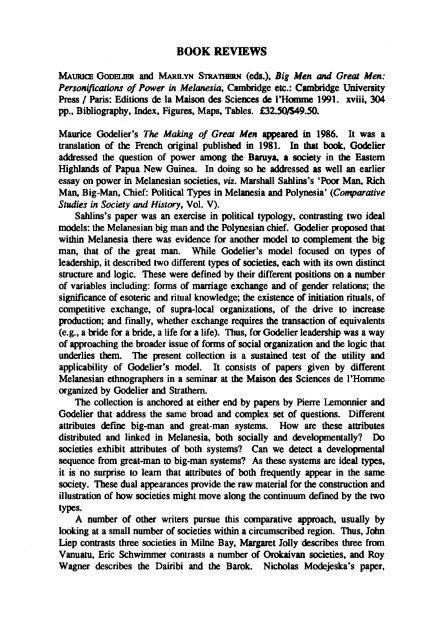1991 No. 1 CONTENTS - Institute of Social and Cultural ...
1991 No. 1 CONTENTS - Institute of Social and Cultural ...
1991 No. 1 CONTENTS - Institute of Social and Cultural ...
You also want an ePaper? Increase the reach of your titles
YUMPU automatically turns print PDFs into web optimized ePapers that Google loves.
BOOK REVIEWS<br />
MAURlCB GODBI..IBR <strong>and</strong> MARn..YN STRA1HBRN (eds.), Big Men tlIId Great Men:<br />
Personifications <strong>of</strong> Power in Melanesia, Cambridge etc.: Cambridge University<br />
Press I Paris: Editions de la Maison des Sciences de l'Homme <strong>1991</strong>. xviii,304<br />
pp., Bibliography, Index, Figures, Maps, Tables. £32.S0/$49.50.<br />
Mawice Godelier's The Making <strong>of</strong> Great Men appeared in 1986. It was a<br />
translation <strong>of</strong> the French original published in 1981. In that book, Godelier<br />
addressed the question <strong>of</strong> power among the Baruya, a society in the Eastern<br />
Highl<strong>and</strong>s <strong>of</strong> Papua New Guinea. In doing so he addressed as well an earlier<br />
essay on power in Melanesian societies, viz. Marshall Sahlins's 'Poor Man, Rich<br />
Man, Big-Man, Chief: Political Types in Melanesia <strong>and</strong> Polynesia' (Comparative<br />
Studies in Society tlIId History, Vol. V).<br />
Sahlins's paper was an exercise in political typology, contrasting two ideal<br />
models: the Melanesian big man <strong>and</strong> the Polynesian chief. Godelier proposed that<br />
within Melanesia there was evidence for another model to complement the big<br />
man, that <strong>of</strong> the great man. While Godelier's model focused on types <strong>of</strong><br />
leadership, it described two different types <strong>of</strong> societies, each with its own distinct<br />
structure <strong>and</strong> logic. These were defmed by their different positions on a number<br />
<strong>of</strong> variables including: fonns <strong>of</strong> marriage exchange <strong>and</strong> <strong>of</strong> gender relations; the<br />
significance <strong>of</strong> esoteric <strong>and</strong> rituallmowledge; the existence <strong>of</strong> initiation rituals, <strong>of</strong><br />
competitive exchange, <strong>of</strong> supra-local organizatioos, <strong>of</strong> the drive to increase<br />
production; <strong>and</strong> fmally, whether exchange requires the transaction <strong>of</strong> equivalents<br />
(e.g., a bride for a bride, a life for a life). Thus, for Godelier leadership was a way<br />
<strong>of</strong> approaching the broader issue <strong>of</strong> forms <strong>of</strong> social organizatioo. <strong>and</strong> the logic that<br />
underlies them. The present collectioo. is a sustained test <strong>of</strong> the utility <strong>and</strong><br />
applicability <strong>of</strong> Godelier's model. It consists <strong>of</strong> papers given by different<br />
Melanesian ethnographers in a seminar at the Maison des Sciences de 1 'Homme<br />
organized by Godelier <strong>and</strong> Strathern.<br />
The collection is anchored at either end by papers by Pierre Lemonnier <strong>and</strong><br />
Godelier that address the same broad <strong>and</strong> complex set <strong>of</strong> questions. Different<br />
attributes define big-man <strong>and</strong> great-man systems. How are these attributes<br />
distributed <strong>and</strong> linked in Melanesia, both socially <strong>and</strong> developmentally? Do<br />
societies exhibit attributes <strong>of</strong> both systems? Can we detect a developmental<br />
sequence from great-man to big-man systems? As these systems are ideal types,<br />
it is no surprise to learn that attributes <strong>of</strong> both frequently appear in the same<br />
society. These dual appearances provide the raw material for the construction <strong>and</strong><br />
illustration <strong>of</strong> how societies might move along the continuum defmed by the two<br />
types.<br />
A number <strong>of</strong> other writers pursue this comparative approach, usually by<br />
looking at a small number <strong>of</strong> societies within a circumscribed region. Thus, John<br />
Liep contrasts three societies in Milne Bay, Margaret Jolly describes three from<br />
Vanuatu, Eric Schwimmer contrasts a number <strong>of</strong> Orokaivan soCieties, <strong>and</strong> Roy<br />
Wagner describes the Dairibi <strong>and</strong> the Barok. Nicholas Modejeska's paper,
















